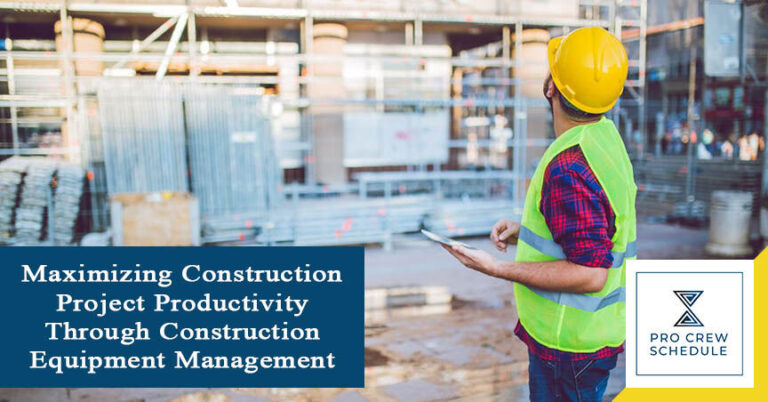Construction equipment management is the process of overseeing the utilization, safety, and maintenance of construction equipment. It involves assessing fleet expenses and utilization, maintaining operational efficiency, and making strategic equipment investments.
Why Effective Construction Equipment Management is Essential
Construction equipment management involves considering expenses, maintenance, and utilization. Effective construction equipment management plays a critical role in ensuring projects are completed safely, on time, and within budget. Proper equipment management can help construction companies through:
- Prolong the lifespan of equipment
- Minimize safety hazards
- Mitigate the risk of unexpected expenses
- Prevent project delays
- Reduce avoidable injuries
The success of any construction project greatly depends on good construction equipment management. Managers who prioritize this aspect stay on top of which equipment is most and least utilized, when maintenance is due, potential repair or replacement needs, and more.
10 Quick Tips for Enhanced Construction Equipment Management
There are various factors to consider when improving your construction equipment management. From safety to maintenance and storage, a construction manager must ensure that workers properly handle all equipment on-site. Here are some major considerations for better construction equipment management that you can implement in your team.
1. Establish guidelines and rules: Construction managers should communicate with the rest of their team how to handle equipment safely and properly. Guidelines should be posted on walls and bulletin boards to be easily accessible to everyone. This information can help reduce wear and tear, decrease additional maintenance and repairs, and improve safety. Strictly follow manufacturer guidelines as your own rules and guidelines for maintenance, including things such as storage and maintenance schedules.
2. Create communication plans: This communication plan outlines the procedures for addressing issues and shows signs that equipment is damaged or needs maintenance.
3. Proper storage for equipment: Proper storage plays a big role in ensuring equipment lasts. Construction equipment should be shielded from external elements when not in use to avoid wear and tear, rust, and other damage. Initial planning should incorporate the additional costs of storage facility expenses or substitutes, like equipment covers.
4. Schedule regular maintenance: Maintenance should be done regularly to prevent damage and ensure that equipment functions well. Managers should assign workers regular inspections using the manufacturer’s guidelines about what to include in regular checks and what signs to look for wear and tear. Manufacturer guidelines are vital for maintenance as they will outline the schedule of tune-ups.
Another consideration is the condition of the job site environment. For instance, job sites with lots of moisture or dust may require more frequent maintenance than the manufacturer recommends. Incorporate your equipment maintenance schedule into your construction crew scheduling software so you never miss a day, and designate a worker for the job accordingly.
5. Track equipment effectively: Monitoring your equipment means keeping an accurate log of all your construction tools and equipment, as well as who is using it and for what activity. Construction inventory management software is available for project managers to use to help them monitor their tools and equipment better.
6. Keep equipment capabilities and limitations in mind: All equipment should not be used beyond its set capabilities or for work it’s not designed for. Improper use can lead to poor workmanship, equipment damage, and potential injury.
7. Secure insurance for your heavy equipment: Insurance for your construction equipment will protect your assets from damage, necessary repairs, and theft. There are various insurance options with varying degrees of protection and coverage. It’s a good idea to look around and compare insurance rates to get the best coverage and price for your equipment.
8. Monitor equipment utilization: It’s vital to monitor how often your workers use equipment. Overuse will impact wear and tear, which can have potential budget implications for additional maintenance or replacement. Alternatively, underusing equipment may be an opportunity to sell or replace it with rental equipment.
9. Apply strict security measures: Theft is a major concern on construction job sites. Security measures involve keeping detailed records of all tools and equipment with serial numbers and securing them properly. You may also consider adding tracking, such as tags, to equipment or hiring private security personnel for larger sites.
10. Ensure that your team has proper equipment training: Workers must know how to use equipment safely and properly. Use training methods, such as readings, classroom style, hands-on demonstrations, and even one-on-one training with more experienced operators.
How To Choose the Right Construction Equipment?
One vital aspect of managing construction equipment is choosing equipment that can be used in different projects. Each project and its corresponding job site have unique specifications that require unique equipment types. Below are strategies to guide you in choosing the right construction equipment for your project.
- Identify Project Needs: First, consider the project requirements and what equipment should be used to complete the project within budget and promptly. Each project will have various needs, but looking at similar recent projects is a good starting point for a baseline reference.
- Asses Site Conditions: The location and condition of the site will be important in choosing the equipment for a project. The terrain, soil classification, climate, area of the space, etc., will influence the equipment selection process.
- Determine Your Equipment Budget: The budget will be one of the biggest deciding factors when choosing equipment for a project. Depending on the budget, your choices may be limited. You may also consider renting instead of buying to best utilize your funds.
- Research Your Suppliers: Engage with reputable suppliers in your area who can provide the equipment you need at a price you’re comfortable with and for the dates you need it.
- Final Equipment Selection: Before finalizing your equipment, you’ll need to review the warranties, policies, and end date before you sign the contract. Right after, you can input it into your construction inventory management software so your team can be informed of your new asset, and you can begin to schedule its usage and designate who will use it.
When Should You Replace Your Construction Equipment?
As critical as equipment maintenance, it’s also vital to know when maintenance costs you more so that it helps you cut costs. Many factors may be of consideration when deciding to replace or get rid of a specific equipment. Here are some things to consider:
- End-of-Use Date: Manufacturer guidelines will specify how long equipment lasts with usual use. However, you must assess your usage and whether it’s above or below the common threshold for construction projects.
- Repair or Recalibration Costs: If equipment is costing more in repairs than the productivity you’re getting out of it, it’s likely time to let it go. Additionally, if you’re spending a high cost on maintaining a piece of equipment that needs replacing shortly, it may be time just to replace it now to save on cost.
- Safety Compliance: As construction equipment ages and becomes out of date, safety issues may arise. If the equipment doesn’t meet the latest environmental or safety standards, it’s time to eliminate it.
- Technological Advances: Some equipment may continue to operate properly but can still be considered outdated. If a new or modern variant of equipment can do the job more efficiently, it may be time to see things long-term and replace the old one.
- Project Specific Needs: Construction projects’ requirements persistently change. A piece of equipment that was essential in the earlier phase may be unnecessary later on. An important part of equipment management is regularly assessing the project’s needs and adjusting appropriately, including returning or selling equipment you no longer need.
Construction management software can help you track the equipment in your inventory. Knowing the current status, location, and end-of-use dates of your equipment makes it easier to make decisions regarding maintenance and disposal. It helps you identify which equipment you can use in your next construction project.
Key Takeaway
Project managers can use many different types of construction management software to help track and manage their equipment. The advantage of using software is that it helps to centralize all information into one source of truth. The construction team, especially the operators, can use the software to enter information about equipment, record issues or repair requests, or track regular maintenance.
Pro Crew Schedule’s construction crew management software features inventory monitoring, enabling teams to have a birds-eye view of all their equipment in a single platform. Moreover, it also shows general information about the company’s project, making it an indispensable tool in overall project management.
Properly managing the equipment you use in construction projects helps your team work more effectively and efficiently. Because equipment is essential in construction operations, adapting construction inventory management software should be a high priority for every construction business.







